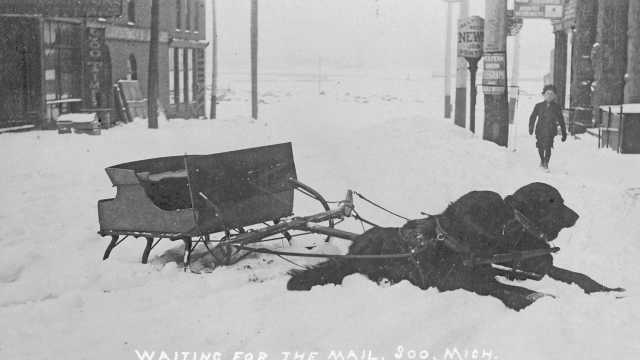By Sterling McGinn
Residents living in the Upper Peninsula especially 125 years ago endured harsh winter living conditions. But they still needed to receive and send mail—even if there was a blizzard.
During those long U.P. winters, it could take two months for mail to arrive, if it did at all. Getting mail in isolated communities was the only communication from the outside world, and brave sled dogs working with a musher offered the main way for communication by mail.
Back then it was not uncommon to see a team of dogs pulling a sled full of mail back and forth to the various small town post offices and even across the ice of the Straits of Mackinac when snow drifts and deep snow made horse and sleigh useless.
Mail transportation via dog sled and team dates to the 1820s in Upper Michigan. A sketch of a dog team pulling a mail sled accompanied by a Native American musher in the Sault Ste Marie area appeared with a cutline in the February 8, 1873, issue of Harper’s Weekly. The cutline stated “Those dwellers in cities who grumble because their letters are delivered but once a day would be quite unhappy in the hyperborean regions of Lake Superior. For more than one-third of the year, the inhabitants of this delectable country are almost as effectually cut off from the outside world as any Arctic explorers.”
At that time, the nearest railroad station from the Sault was at Marquette, 180 miles distance. Twice per week, a dog team traveled over snow and ice and encountered horrific weather to bring the mail to Marquette. If there were no delays, and the mail arrived on time, someone sending a letter to New York would likely receive a letter back in a little less than two months.
On the local scene, dog teams transported winter mail back and forth from Newberry to Deer Park, a lumbering community at Muskallonge Lake. Along with the sawmill and lumbering community, Deer Park was also home to a U. S. Life Saving Station, which later was taken over by the U. S. Coast Guard.
The community boasted its own post office from 1888 to 1899. However, the crude road between the two communities was often impassable in the wintertime.
Local lumberman and early saloon and hotel entrepreneur D. N. McLeod owned two dogs named Grover and Cleveland—of course named after U.S. President Grover Cleveland. His brave companions were often harnessed to a sled to bring the mail to Deer Park when a horse and sleigh couldn’t make the trip. The two dogs made numerous trips in the early 1890s.
Dangerous attempts to transport mail via horse and were still made, often with disastrous results. The Newberry News of February 10, 1893, reported that the Deer Park and Newberry horse-drawn mail carrier had a narrow escape while on his route.
“When he left Newberry early this morning, he found the road in very bad condition. Late in the afternoon, he crossed the Two Hearted River and entered the open country through which the road runs the balance of the way to the Park, and after a vain attempt to urge his exhausted team through the snow drifts, he unhitched the animals and left them at liberty to care for themselves.”
The mail carrier put the mail bags on his shoulders and took to Deer Park on foot, but before he arrived at his destination, he lost sight of the road and became lost due to the storm and night falling. Meanwhile, a search party dispatched to look for the mail carrier. The party found the missing man clinging to the mail bag and was rescued. One of the carrier’s horses was found; the other presumably died in a swamp.
An item in a January 1899 issue of The Newberry News reported William Green’s experience of bringing the mail from Deer Park.
“A regular blizzard was raging and when he reached the plains all traces of a road had been obliterated. He was finally obliged to abandon his sleighs and return to the Park, where he secured a cutter and hired a man to accompany him. He then made another attempt, and this time was successful, arriving here between 10 and 11 o’clock that night.”
Dog teams also brought supplies to the Life Saving Stations along the shore of Lake Superior and to other isolated areas such as Grand Marais.
In early 1900s and early teens, dog sled mail services became less common. These days, the mail dogs are often companions to rural mail carriers, poking their heads out the window to sniff the news of the world while their owner slides deliveries into roadside mailboxes.







